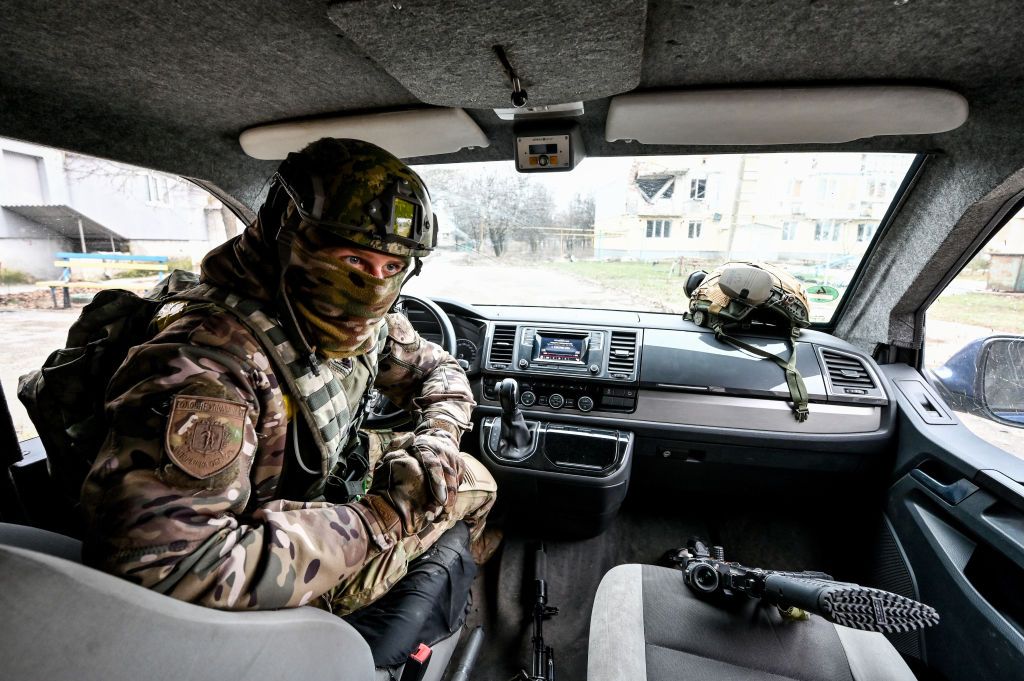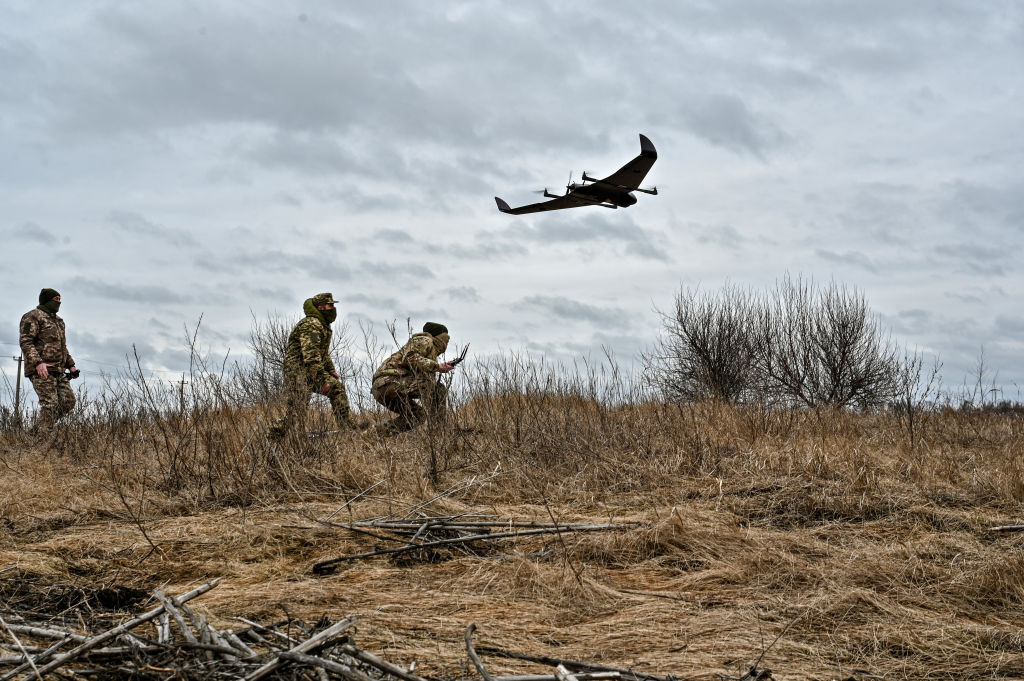Stranded civilians brave shelling, return to Ukraine’s front-line towns

ORIKHIV, HULIAIPOLE, Zaporizhzhia Oblast – A massive rumble shakes the basement under the partly destroyed administrative building, followed by another blast much closer.
“Not good,” says 51-year-old Svitlana Mandrich, Orikhiv’s deputy mayor, looking warily at the sandbags protecting the cellar’s vent.
Mandrich is in charge of keeping the small community running, braving the round-the-clock shelling to help the nearly 2,000 residents who have decided to stay.
The thunder of missiles never stops around the front-line town of Orikhiv, 60 kilometers south of Zaporizhzhia and only a few kilometers from Russian positions in the south.
“We can’t keep track of the bombings,” Mandrich says. “Sometimes, we can’t leave the basement all day.”

Once, she managed to count over 300 explosions over the course of eight hours, but sometimes it’s up to 500 times per day. This morning, on March 4, locals had already counted 20 blasts in the span of two hours due to nearby fighting, often targeting the city itself.
Because of the proximity of Russian troops and the number of attacks, the air raid sirens are of no use in two front-line towns – Orikhiv and Huliaipole.
Each of the towns used to have around 14,000 people before the invasion. Now, the several thousand that remain live most of the time in dank, dark basements to avoid being killed in the next strike.
Shelling has killed around 30 people in Orikhiv since the beginning of the invasion. “It doesn’t look like a lot, but we’re a small town, so it feels like a lot,” Mandrich says.
And yet, the danger doesn’t keep people away.
Some of those who fled Orikhiv now try to return to the city despite her efforts to dissuade them, Mandrich says. Evacuation buses operate five times a week, but they usually leave Orikhiv empty.
The same goes for Huliaipole, roughly 40 kilometers east, where over 1,000 people remain, according to the military garrisoned nearby.
Roughly 60 children are still in Orikhiv, Mandrich says with a pained look.
Most people who stay are pensioners and the vulnerable, often too poor to leave the town and look for a future elsewhere.
“We ask them to leave because it’s too dangerous,” she says, having no illusion that most will stay because they have nowhere else to go.
Not enough body bags
Oleksiy Tychynskyi, a 49-year-old construction worker, returned to Orikhiv in October 2022 after staying in Zaporizhzhia for a few months.
“Home is home,” he says, even if it’s a dark basement.
“At least here we have something,” Tychynskyi says, showing the dark cellar, only lit by a single torch lamp hanging from the ceiling.

He and his wife decided to stay because it’s “too expensive” to live somewhere else. “And the sofas (at home) are comfortable.”
It’s also a matter of pride for the couple. “What’s gonna happen if everyone leaves?” Tychynskyi asks.
“We are the keepers of the town,” he jokes, adding he also helps the most vulnerable people.
Still, Tychynskyi admits the months of November through March were rough, describing waves of relentless strikes, “sometimes 400 times a day.”
“Of course, they only attack military bases and military infrastructure,” he adds sarcastically. “That’s why almost everything is destroyed here.”
As the Russians were pushed back from the city, they dug in further away and resorted to heavier equipment to hit Orikhiv, attacking with everything they have, Mandrich says,
“It can be Grad missiles, Uragan missiles, mortars, sometimes even missiles from helicopters,” she says.
“The scariest are cluster munitions,” designed to scatter small explosives for maximum damage. Even when cluster munitions fail to explode, the slightest vibration can set them off.

A volunteer died on May 11 when shrapnel from a cluster munition sliced his head, she recalls. That day, four people died, and eight were wounded.
Emergency services don’t come to Orikhiv anymore, which means the residents have to take care of everything themselves, including providing first aid to the wonder or burying the killed.
Mandrich and her team had to drive along the front line to collect bodies constantly.
“We just put on a (bulletproof) vest and a helmet, but we didn’t have enough body bags,” she says.
Her own house was hit by a thermite bomb that scattered flammable material and began to burn everything in her backyard.
She couldn’t go out, so she had to wait for someone to help her put sand and soil on the fire, as adding water would only make the blaze worse. The only thing that saved her was her metal roof.
Since then, she has stayed in her basement.
A potbelly stove runs all day because the basement is too damp otherwise. She uses an old well nearby to get water, like most residents she’s in charge of.
Some can’t care for themselves and rely heavily on her six-person team.
They set up nine “invincibility centers” in the town’s basements, where people can charge their devices, drink something warm and contact their relatives thanks to a Starlink connection.
“Some people live there all the time,” she says.
Shattered buildings
Residents tend to avoid the large road scarred by the deadly pattern of the cluster munitions’ impacts. Staying in the open too long can mean death in Orikhiv.
The road leads to a school that opened months before the full-scale invasion, and is now reduced to a pile of glass and concrete. The modern building was struck by an S-300 missile, leaving a gaping hole where children used to visit.

Not far from the shattered school, Valentina Avramenko, a 77-year-old pensioner, sits on a bench, enjoying the first warm days while bangs continue to shake the town in the background.
She’s one of the rare residents who stayed in her flat instead of hiding in a basement.
The only resident in her five-story building, damaged by a missile strike, she survives only thanks to the humanitarian aid distributed by volunteers, including her prized possession, a blue coat that “keeps warm at night.”
She refuses to leave her apartment despite the bombardments and the absence of electricity, water, and heating.
“Some volunteer asked me to evacuate, but I’m too tired,” she says. “Where would I go?”
A missile strike in October 2022 almost destroyed her building. She was “lucky” to be there when the fire broke out, she says.
“I would have lost my apartment if I wasn’t,” she smiles, showing the charred ceiling of her cold, burned-down kitchen.
‘We’re not afraid’
Similar devastation reigns in nearby Huliaipole.
The entrance of the town, barred by heavily protected checkpoints, is surrounded by a patchwork of broken houses and shapeless roofs.
The Ukrainian flag floats near the black and white flag of anarchist and early 20th century revolutionary Nestor Makhno, emblazoned with a skull and his signature “Freedom or Death” motto.
The famous Ukrainian revolutionary, born in Huliaipole, who fought in the surrounding steppe, has his statue protected by sandbags. The pedestal, surrounded by craters, is still standing.

Russian troops briefly entered Huliaipole on March 5, last year, but were quickly repelled.
The front line eventually settled just outside the town, with the closest Russian positions only a few kilometers away, leaving them within range to raze the city to the ground.
There’s not much left of the historic brick buildings in the center. Russians destroyed most buildings in the area, leaving only a lonely “I love Huliaipole” sign in front of the mountain of ruined concrete.
Most roads are deserted in Huliaipole, except for a few civilians strolling between the ruins.
A mother in a tracksuit walks among the ruins, holding a little boy by the hand, who waves at the dusty jeep.
“There are still children here, even though we evacuated a few,” Ashot, a drone unit commander based in the region, says as the car passes by the rear civilians in the area.
Oleksiy Semko, a 54-year-old mechanic, is one of the last residents of his street, scattered with half-broken, windowless homes.
Semko still has a couple of cows, some pigs, and chicken left, despite a shelling that burned one of his sheds in January.
“Who’s gonna take care of my animals if I leave?” he asks, showing remnants of incendiary bombs fallen.
“Home is better than anywhere else,” he hammers.
In the town center, a hospital has been attacked at least three times by S-300 and Pion artillery, leaving massive burned holes on the facade.
Valentina and Natalia, two 60-year-old retirees, gossip on the porch, unperturbed by the deafening sound of blasts shaking the town.
They don’t plan on evacuating.
“Everyone who wanted to evacuate, already evacuated,” Natalia says. “I didn’t because I don’t want to, I still have chickens and dogs here.”
“We’re not afraid,” she adds.
“Before the invasion, we didn’t care about Russians, but you can’t imagine how much we hate them and their language now,” says Natalia.
Valentina has only one regret. She wishes the military would teach them about weapons.
“It would be nice if the guys taught us how to shoot from a rifle and take care of it because we don’t know how,” she says. “I know how to throw a grenade, though,” she laughs.




















